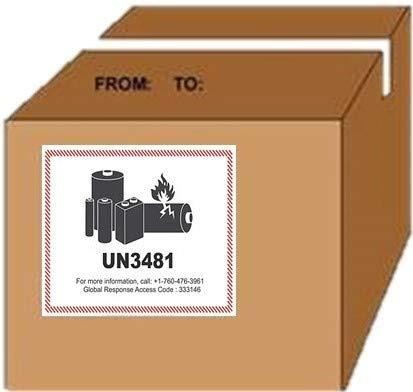Lithium batteries have become the preferred energy source to power a wide variety of consumer goods ranging from mobile phones to children toys to cars and e-bikes. Though widely used, most people are not aware that lithium batteries are dangerous goods that can pose a safety risk if not prepared in accordance with the transport regulations.
Paste any of the below suitable Lithium battery labels (see the image below) on the outermost packaging of the product for all orders containing items with Lithium batteries:
- UN3481 label on packages containing Lithium ion batteries contained in equipment or Lithium ion batteries packed with equipment.
- UN3091 label on packages containing Lithium metal batteries contained in equipment or Lithium metal batteries packed with equipment.

For shipping products containing lithium batteries, make sure that you have additional packaging over the manufacturer’s box and never ship the item only in the manufacturer’s packaging.
Sharing an example of a transport label, which needs to be pasted on the dangerous goods package
Requirements for lithium batteries and products that are shipped with lithium batteries
Lithium batteries are widely used and characterized by:
- Long life
- No memory effect (they don’t lose their maximum energy capacity)
- Slow loss of charge when not in use
While useful, they can also be dangerous. If damaged, dropped, crushed, or short-circuited, they can release dangerous amounts of heat and may ignite. They are also dangerous when exposed to heat. For these reasons,
lithium batteries are always subject to specific transport requirements.
How do I know if my product contains a lithium battery?
Products containing lithium batteries do not have a specific sticker or symbol allowing you to recognize them. You can however easily recognize them by either looking at the battery itself (the battery composition is generally printed on the battery) or by reading the manufacturer’s documentation (e.g., product manual). You can also contact the supplier to learn more about your product.
Types of lithium batteries
There are many different types of lithium batteries. The three main types are described here.
For more information, see
Lithium batteries on the International Air Transport Association (IATA) website.
Lithium-ion batteries
Lithium-ion batteries (Li-ion or LIB batteries) have lithium compounds as the electrode material, and are
rechargeable. Li-ion batteries are widely used in portable electronic products such as mobile phones, laptops, tablets, MP3 players, and cameras.
Lithium metal batteries
Lithium metal batteries have lithium metal as an anode and are
generally not rechargeable. They come in different shapes and forms, including the flat, round batteries used in watches. They are also commonly used in products such as calculators or flashlights.
Lithium-ion polymer batteries
Lithium-ion polymer batteries, often called lithium polymer batteries (Li-poly, Li-Pol, LIP, PLI or LiP) are rechargeable batteries usually composed of several identical secondary cells in parallel. They are used in some portable electronic products and fall under the family of lithium-ion batteries.
Regulation of lithium-ion batteries
Lithium batteries are always subject to specific transport requirements, without exception.
Lithium-ion batteries can have a very high stored energy content, and this is why Amazon will not ship some lithium-ion battery products.
For more information, download
lithium battery guidance from the International Air Transport Association (English only).
 For shipping products containing lithium batteries, make sure that you have additional packaging over the manufacturer’s box and never ship the item only in the manufacturer’s packaging.
Sharing an example of a transport label, which needs to be pasted on the dangerous goods package
Requirements for lithium batteries and products that are shipped with lithium batteries
Lithium batteries are widely used and characterized by:
For shipping products containing lithium batteries, make sure that you have additional packaging over the manufacturer’s box and never ship the item only in the manufacturer’s packaging.
Sharing an example of a transport label, which needs to be pasted on the dangerous goods package
Requirements for lithium batteries and products that are shipped with lithium batteries
Lithium batteries are widely used and characterized by: